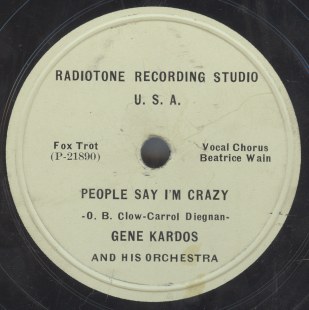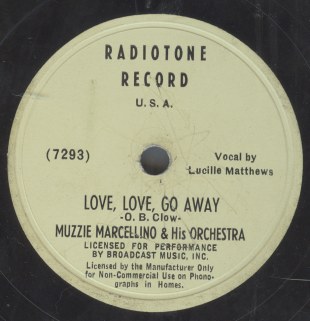

 May 2009
May 16
This
week's Hit of the Week is
brought
to you by Click
here
or on image for larger view
General Electric Refrigerator (from 1941 ad)  
People
Say I'm Crazy A
Little After Eight Love
Love Go Away This
Is What I Call Real Love
Here are a couple of
records on the hard to find Radiotone label. I picked these up in
a box of records I purchased awhile back but it wasn't until a few
weeks ago that I paid much attention to them and realized their
significance. Radiotone was a small
label - some might even call it a "vanity label" - issued by Tacoma,
Washington entrepreneur and part-time songwriter O. B. Clow as a means
of showcasing his own compositions. Born in 1886, Oscar
Blair Clow was a modern day renaissance man. He was a successful
inventor and real estate developer who owned a number of
restaurants including a chain of waffle shops which, at its height, had
52 locations in various cities. He also owned the Clow
Milling Co. which made and distributed Clow's Waffle Flour. Though Clow was a
prolific composer and wrote several hundred songs he was unable to read
or write music and relied on his pianist, Hy Seaman, to put his songs
on paper. Clow was also among
the early composers to license his compositions through the newly
formed Broadcast Music Inc.(BMI) and he made his entire body of work
available through that organization just in time for the 1941 radio
industry strike against ASAP. BMI was founded in
1939 by a consortium of radio stations as an attempt to challenge the
near monopoly over music licensing held by ASCAP. The
organization was formed in anticipation of the expiration of the radio
industry's five year license agreement with ASCAP at the end of 1940.
Because the vast majority of radio stations refused to go along
with ASCAP's demand for a 100 percent increase in annual fees,
all ASCAP compositions were effectively banished from the radio
airwaves beginning January 1, 1941. The 1941 ASCAP strike
had far reaching consequences for the music industry and provided
sudden new opportunities for regional song writers such as
Clow. In the 1930s ASCAP was dominated by the New York
based Tin Pan Alley publishing houses - the top 15 of the 140
publishing houses it represented accounted for about 90 percent of the
music heard on the airwaves. Additionally, in order to
become an ASCAP member and collect royalties, a songwriter had to
have a minimum of five published songs. Because virtually
all music performed on stage, screen and on radio was, at the time,
licensed through ASCAP, the system favored and helped perpetuate
established publishing houses and composers and made it difficult for
new talent and more obscure genres of music to come to the public's
attention. (A very similar situation has emerged in recent decades with
the near total lock the RIAA has had over the music industry which,
fortunately, is starting to unravel as a result of the Internet). By contrast, BMI was
willing to allow any songwriter to become a member and be immediately
eligible to collect royalties. With the 1941 strike, radio
station executives and the bandleaders who performed on network
broadcasts were suddenly scrambling to find new works by non-ASCAP
writers. The strike was disastrous for ASCAP in ways far
beyond the fact that it was forced to settle with the radio stations
later that year for a smaller increase in fees. After the
strike, radio stations continued to perform and expose audiences
to BMI material. And since BMI was willing to license
genres such as country and rhythm and blues that ASCAP had shunned, by
the 1950s, the overwhelming majority of popular music heard on the
airwaves was licensed through BMI. I have not been able
to determine how many of Clow's Radiotone records were pressed or how
they were distributed. Earlier issues show the name as "Radiotone
Recording Studio." Later issues say "Radiotone Record." The Gene Kardos sides
featured here are two of six Clow compositions the Kardos band cut for
release on Radiotone in an October 15, 1937 recording session at the
American Record Corporation's New York City studios. Four other
non Clow compositions were also recorded during that same session and
issued on ARC labels such as Melotone and Conqueror. It is
highly likely that ARC also pressed the Radiotone records from this
session. Brian Rust's American
Dance Band Discography lists the Kardos Radiotone sides as
"Private Recording" which, to me, suggests that Clow most likely
offered ARC money to make recordings of his songs. Why the
Gene Kardos Orchestra in particular was chosen for the sessions and
what connection Kardos might have had with Clow is not known. I have not been able
to find any discographical information about the Muzzie Marcellino
sides. However, on both sides of the record MUZZY
Marcellino's first name is misspelled as "Muzzie." Marcellino is
best remembered as a mid-1930s vocalist with the Ted Fio Rito
Orchestra. Between 1938 and 1948 Marcellino successfully fronted
his own band which confined most of its activities to the West
Coast. Brian Rust's discography does not list any recording
sessions by Marcellino's band so I have no way of knowing whether these
recordings were outsourced in a way similar to the Kardos sides.
It is known that in late 1940 Clow had a recording studio
located in the Annobee Apartments, an innovatively designed Tacoma
apartment complex Clow built in 1925 and which is now listed on the
National Register of Historic Places. I suppose it is possible
that the recording sessions could have taken place there. I did
find an online listing for sheet music of "Love Love Go Away" which
indicates the song was published by Clow in 1940. My guess is the
record was made sometime between then and Clow's death in 1942. Bea Wain, featured on
"People Say I'm Crazy," is best remembered as a highly successful
vocalist with the Larry Clinton Orchestra which she joined less than a
month after this recording session with the Kardos band. Wain is
one of the few artists featured on this site who is still with
us. You can listen here to a
lengthy and interesting interview with Bea Wain recorded shortly before
her 90th birthday in 2007.
EXTRA
This section
will present
78 rpm recordings that do not fall within the range of the vintage pop
and jazz fare that I usually present. Here I will
feature
recordings from a wide variety of eras, musical genres and
nationalities
as well as occasional spoken word recordings. Arrah
Wanna Medley
Here is an
old 12 inch single sided Victor Grand Prize label disc that goes far
enough back that the record company did not deem it necessary to give
any artist credit beyond a generic "dance orchestra" description.
"Arrah
Wanna: An Irish Indian Matrimonial Venture," published in 1906, was
composed by Theodore F. Morse who had had a number of ragtime and
popular tunes to his credit. The song's title refers to the name
of an Indian maid in its lyrics by Jack Drislane. Around
that time there were a number of popular songs which had some sort of
American Indian theme. Observe
that the band speeds up considerably in the last fifteen seconds of the
recording. Perhaps this was intentional - or perhaps the
conductor suddenly realized that the record was about to run out. - Dismuke
If you have questions or comments about the music or would simply enjoy interacting with friendly people who share your interest in it, join in the conversation on Dismuke's Message Board. May 3
This
week's Hit of the Week is
brought
to you by Lightweight
Remington Typewriters
(from 1932 ad) All
Of A Sudden If
I Were Only Sure Of You Courtesy of the the
collection of Matt From College Station, here
are two of the only four sides ever recorded by an all-but-forgotten
1930s dance band. Lew Conrad was best
known on radio as a star vocalist on NBC in the early 1930s when he was
for a brief while considered to be an up-and-coming
"crooner." Both of Conrad's
parents were vocalists; his father was a soloist at the Cathedral at
Tours in France and his mother sang in a church choir in Leeds,
England. However, since they wanted their son to become a
musician rather than a vocalist, Conrad studied violin. By his
early teens Conrad was billed as a child prodigy and spent two
miserable weeks on a vaudeville circuit which he quit as soon as his
agreed upon engagement was up. After his father died,
Conrad had to support both himself and his mother while he attended
high school and, later Tuft's University. "I went to classes most of
the day, had rehearsals and played in dance orchestras in the evening
and it usually was past midnight when I started to study for the next
day's classes. So I formed the habit of sleeping but four or five hours
each night. I still do" Conrad told a newspaper reporter in 1931 (The Lincoln Star, May 10, 1931 p 39) After graduating from
Tufts, Conrad spent a year with the Cleveland Symphony Orchestra before
joining the Leo Reisman band as a violinist and vocalist. In
addition to recording sessions with Reisman , Conrad also
performed in several studio orchestra recording sessions for Nat
Shilkret and Ben Selvin. Around 1929 he was given an audition for
the National Broadcasting System and began appearing in NBC
programs. He was offered an exclusive contract with the network
in September 1930. In May 1931, Conrad
reflected on the opportunities that the advent of radio opened up for
vocalists: It has also meant that we
can do the thing we most want to do - sing - and still (San Antonio Express, May
24, 1931 p. 56) The period between 1931 and 1933
seems to have been the peak of Conrad's fame. By the spring of
1931,
Conrad could be heard cost to cost on network radio nine different
times each week. In 1933 his band was featured in an installment
of
the Warner Bros/Vitaphone series of musical shorts 'Rambling Round
Radio Row. After 1933, however, mentions of
Conrad in archived radio
newspaper radio programing listings become scarce until 1937 and
1938. The latest mention I could find of him and his
band being active was
from mid 1941, though it is possible that it might have continued on
after that.
EXTRA
This section
will present
78 rpm recordings that do not fall within the range of the vintage pop
and jazz fare that I usually present. Here I will
feature
recordings from a wide variety of eras, musical genres and
nationalities
as well as occasional spoken word recordings. 'Leventhirty
Saturday Night Me
And The Girl Next Door Eddie
Walters was a vocalist and ukulele player who was briefly popular on
radio and records in the late 1920s and early 1930s. On records
he cut about 10 sides under his own name and performed in recording
sessions with Ben Selvin and other studio bands. Unfortunately, I have
not been able to locate much more about him in terms of biographical
information. These selections also come courtesy of Matt From
College Station. - Dismuke
If you have questions or comments about the music or would simply enjoy interacting with friendly people who share your interest in it, join in the conversation on Dismuke's Message Board. |
|
|
|
|
|
|